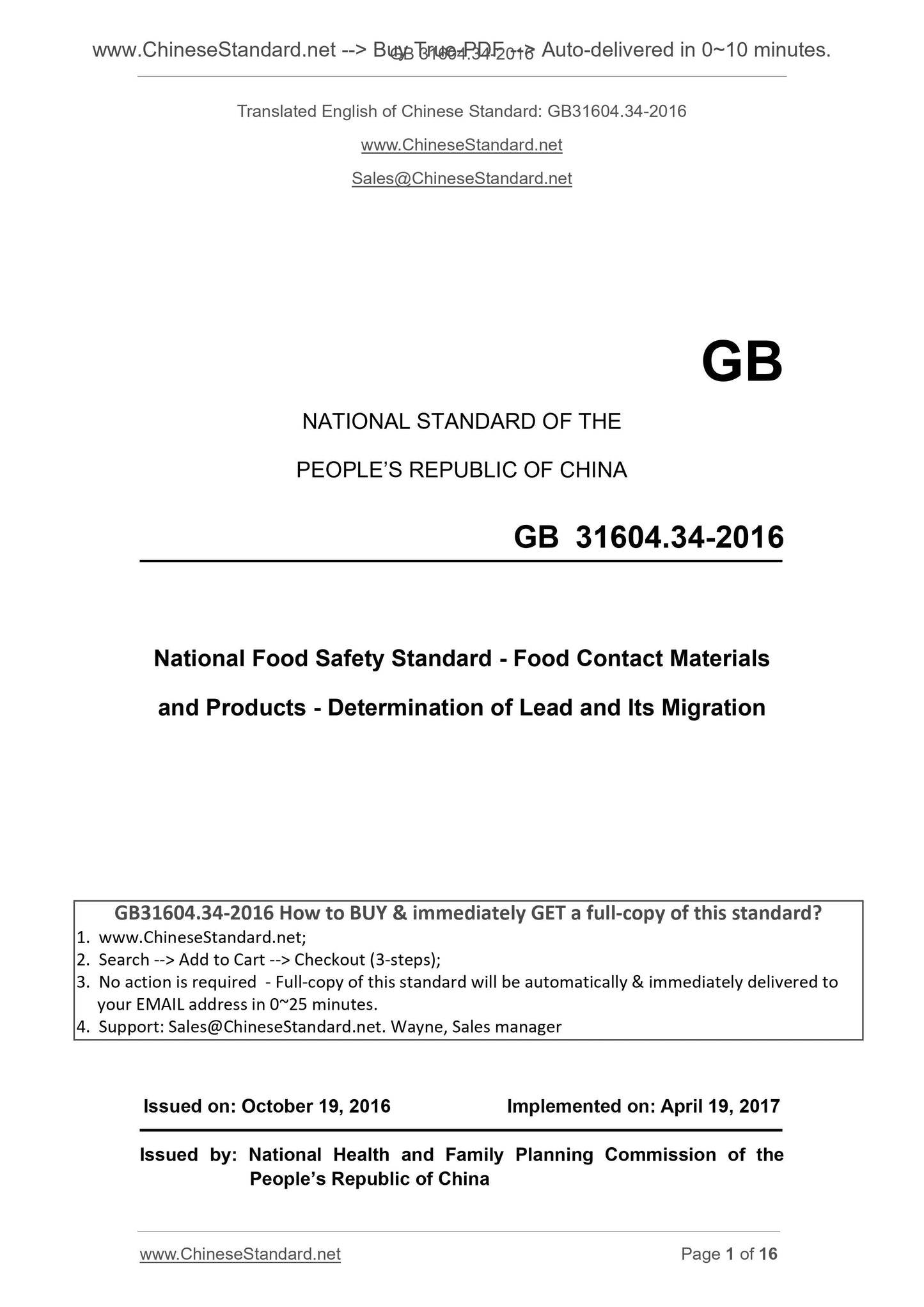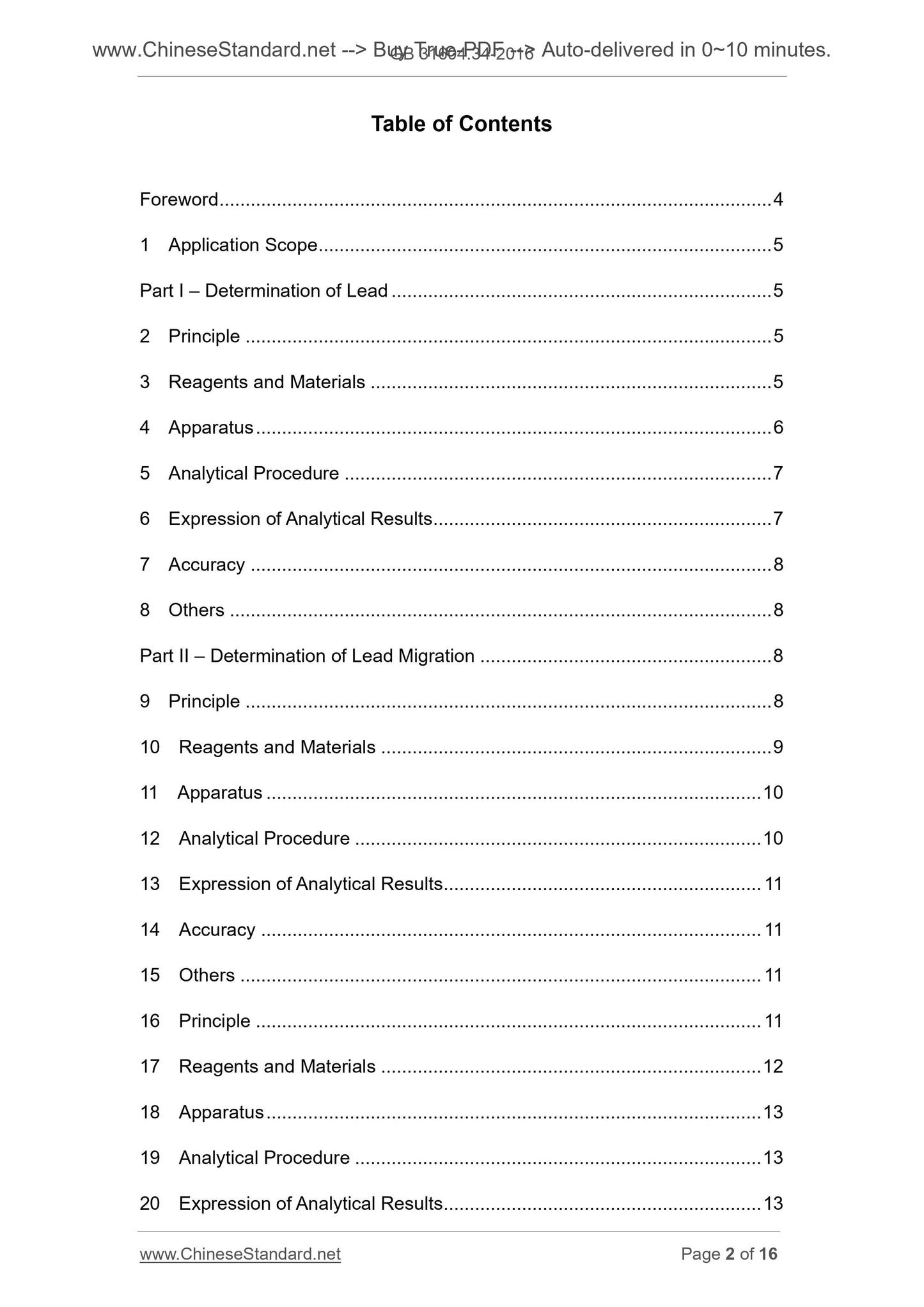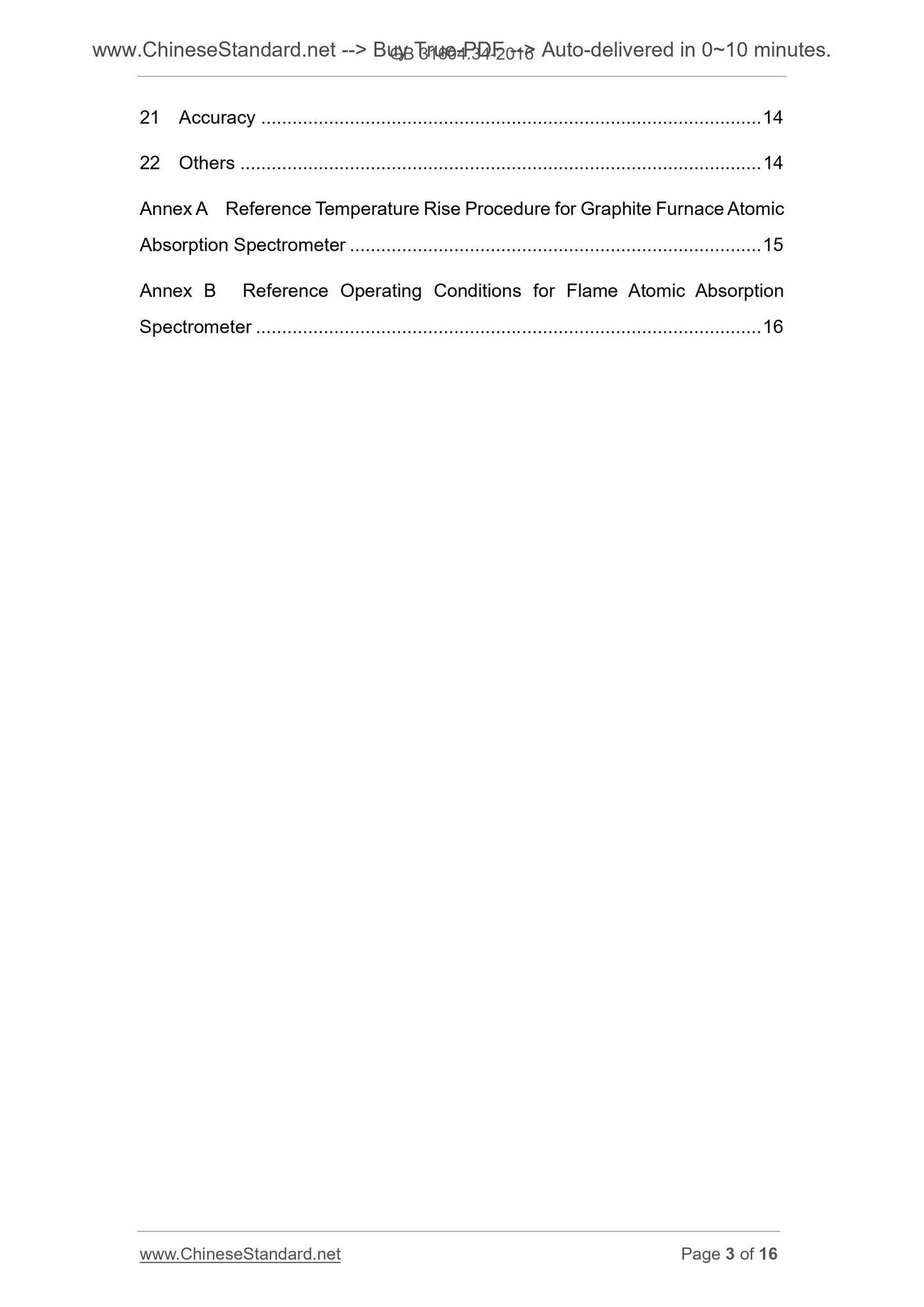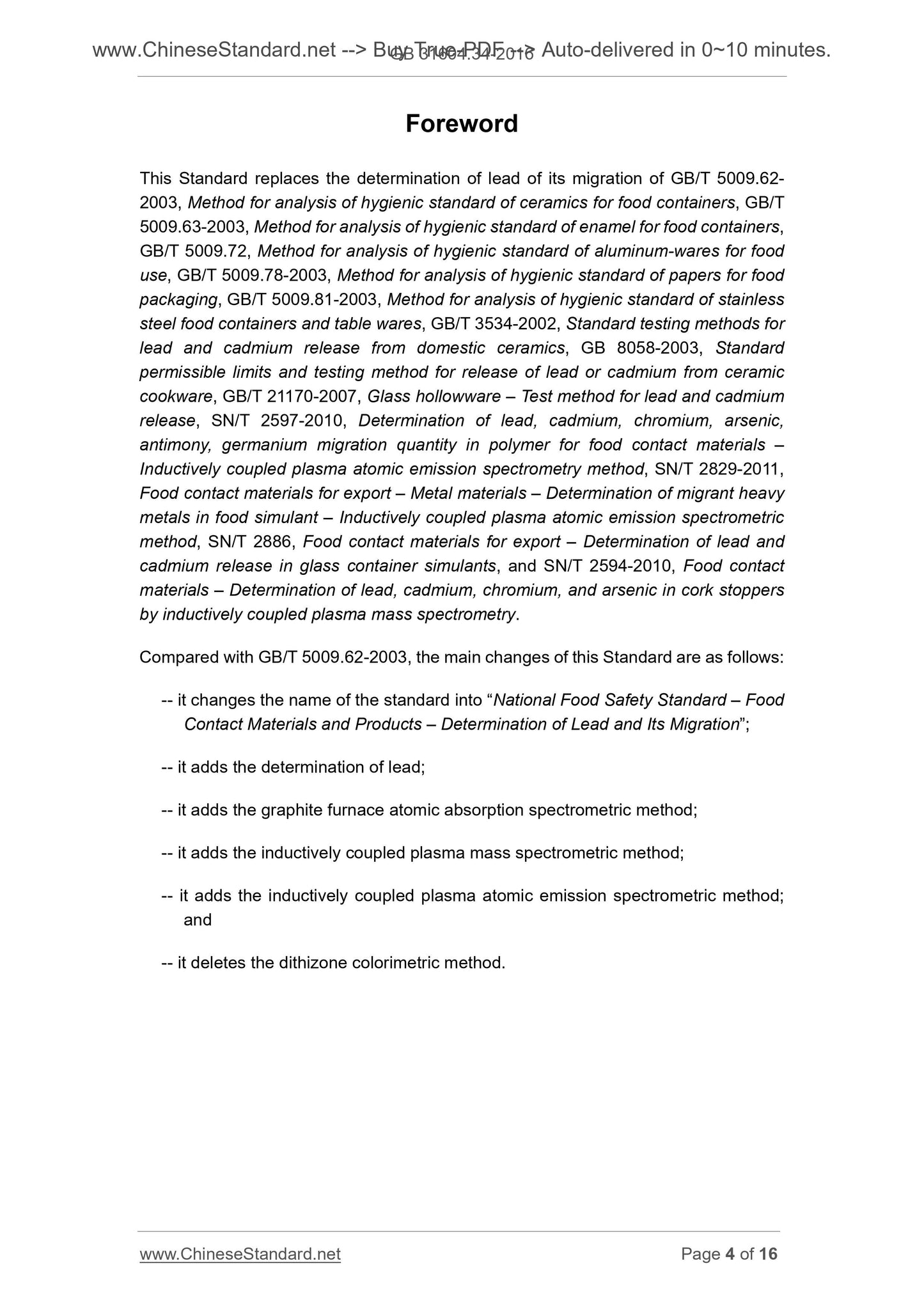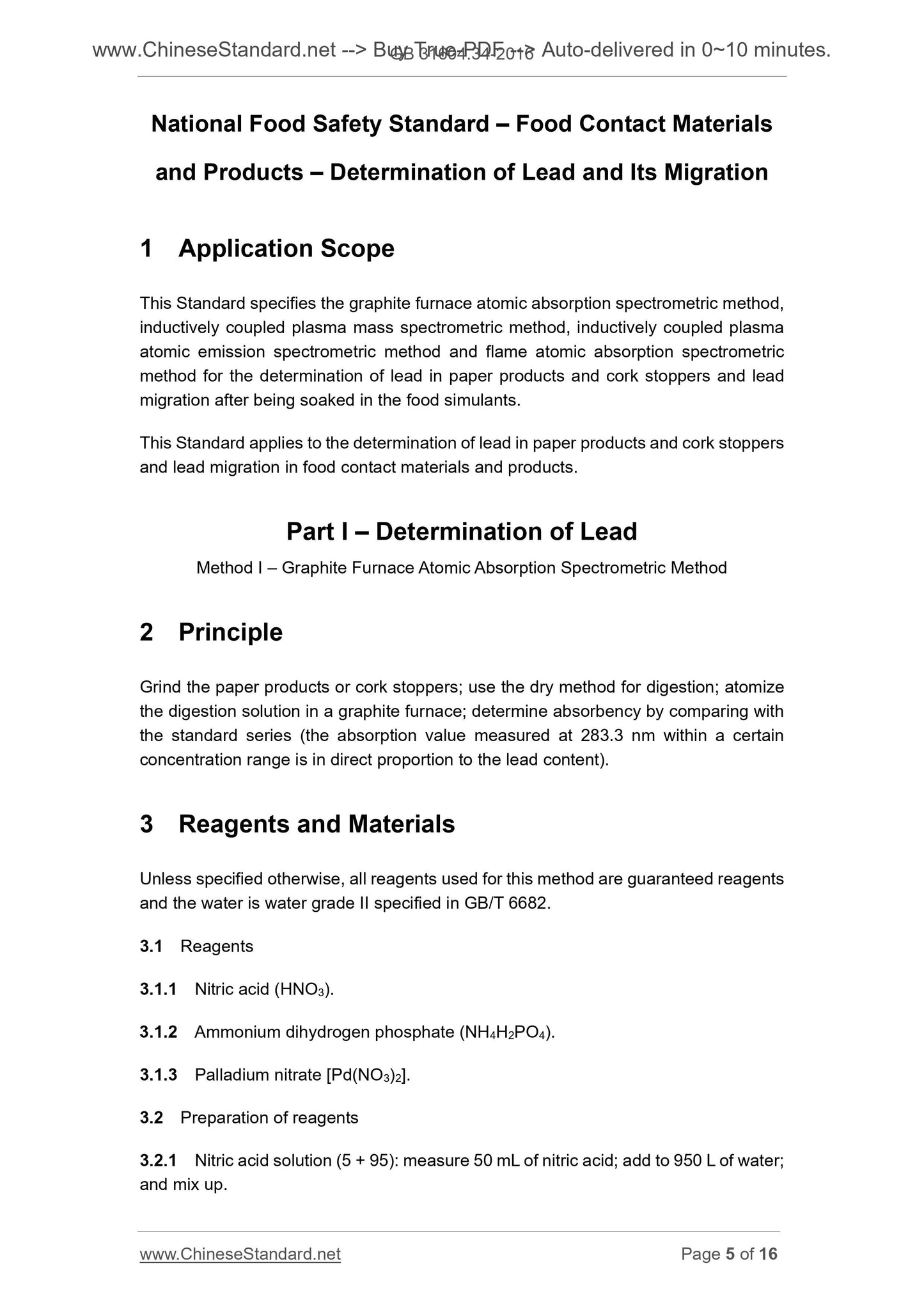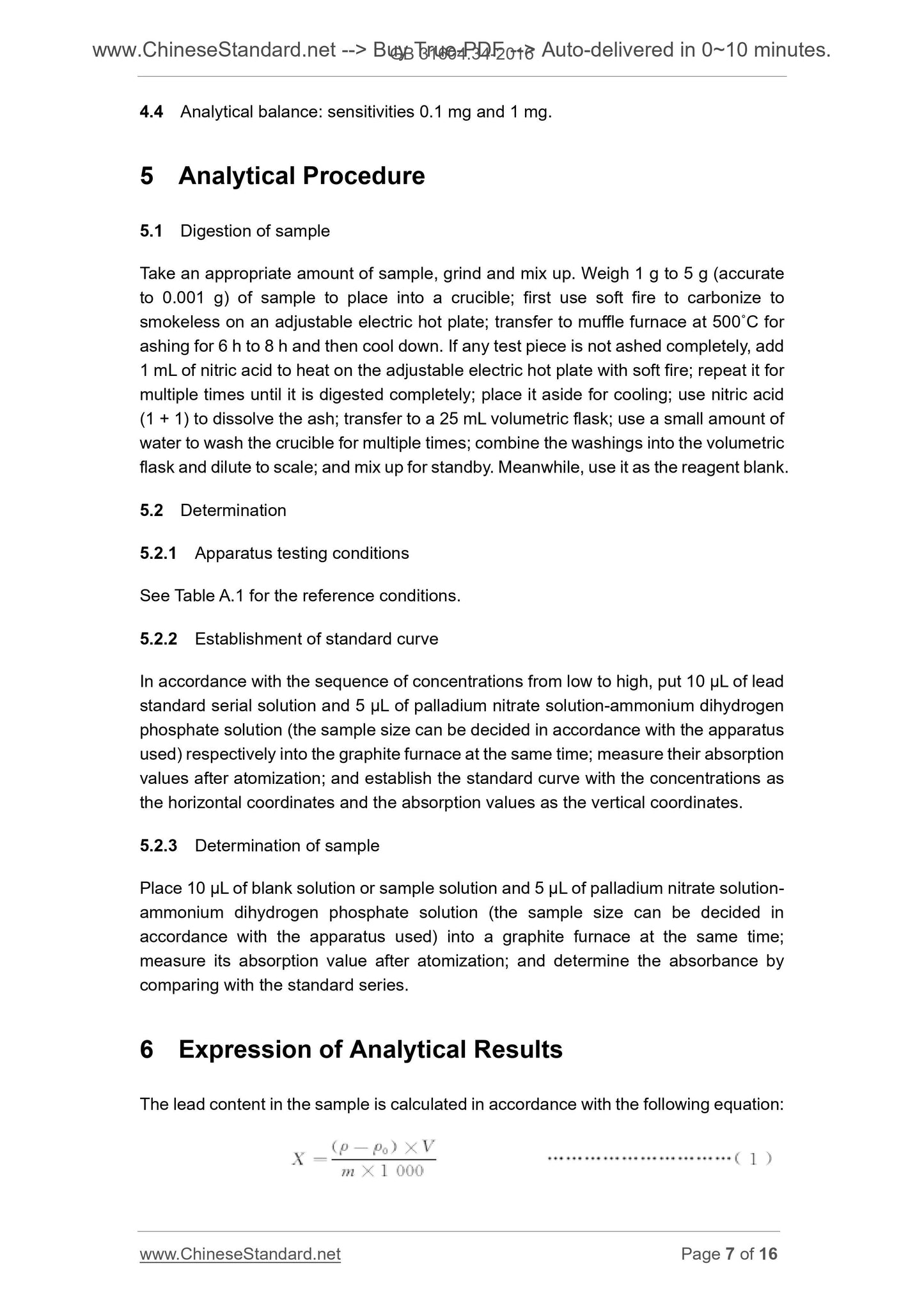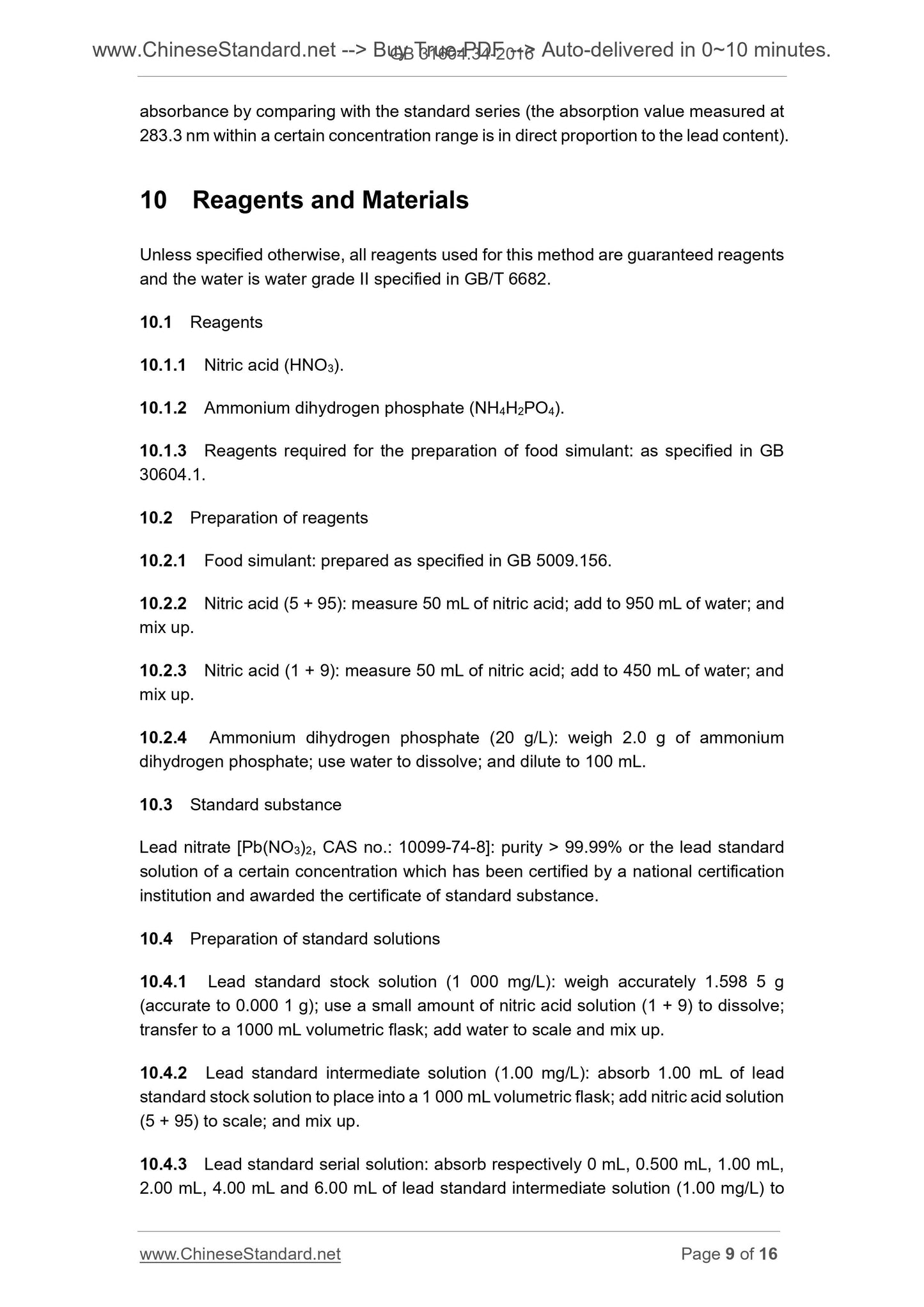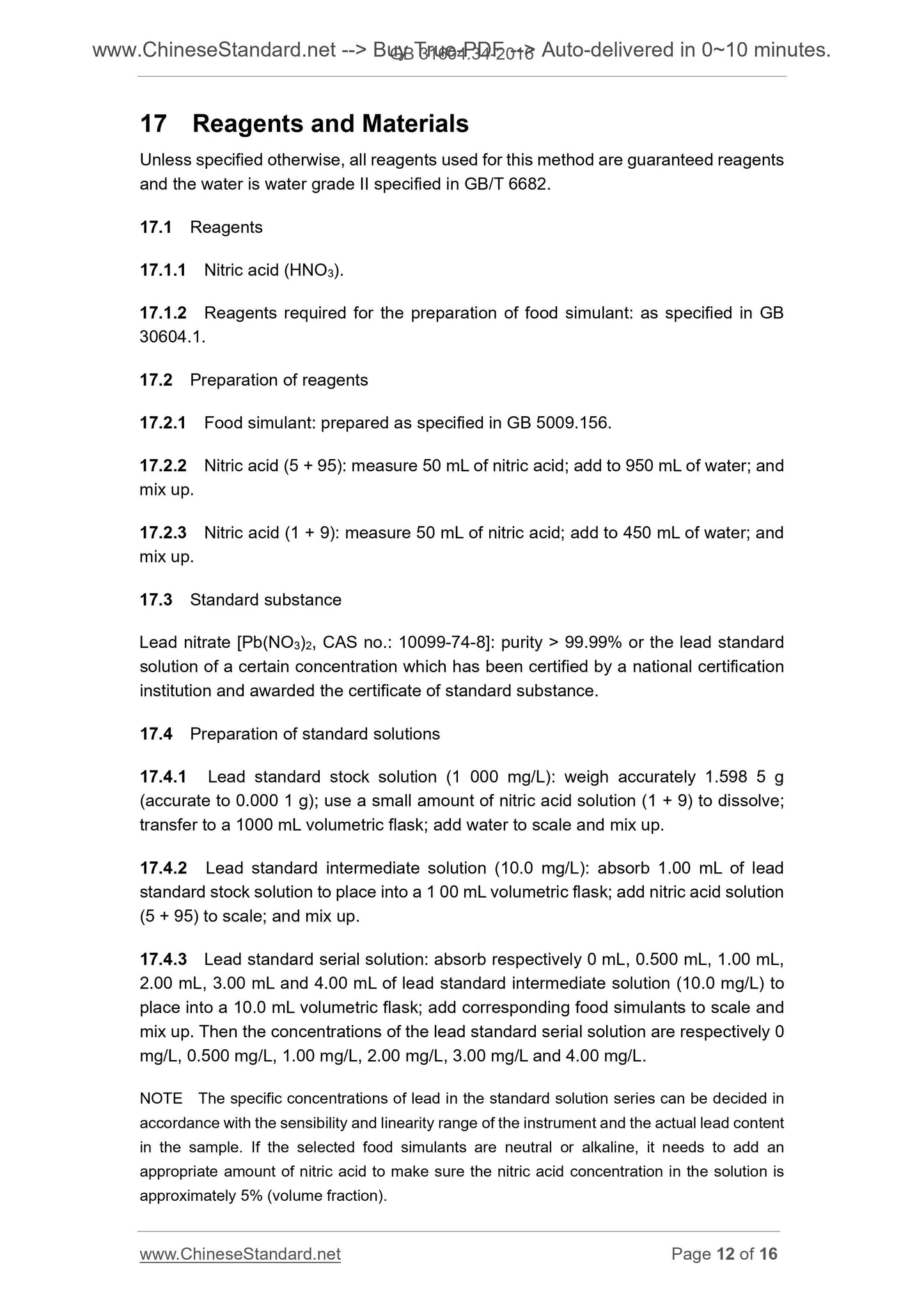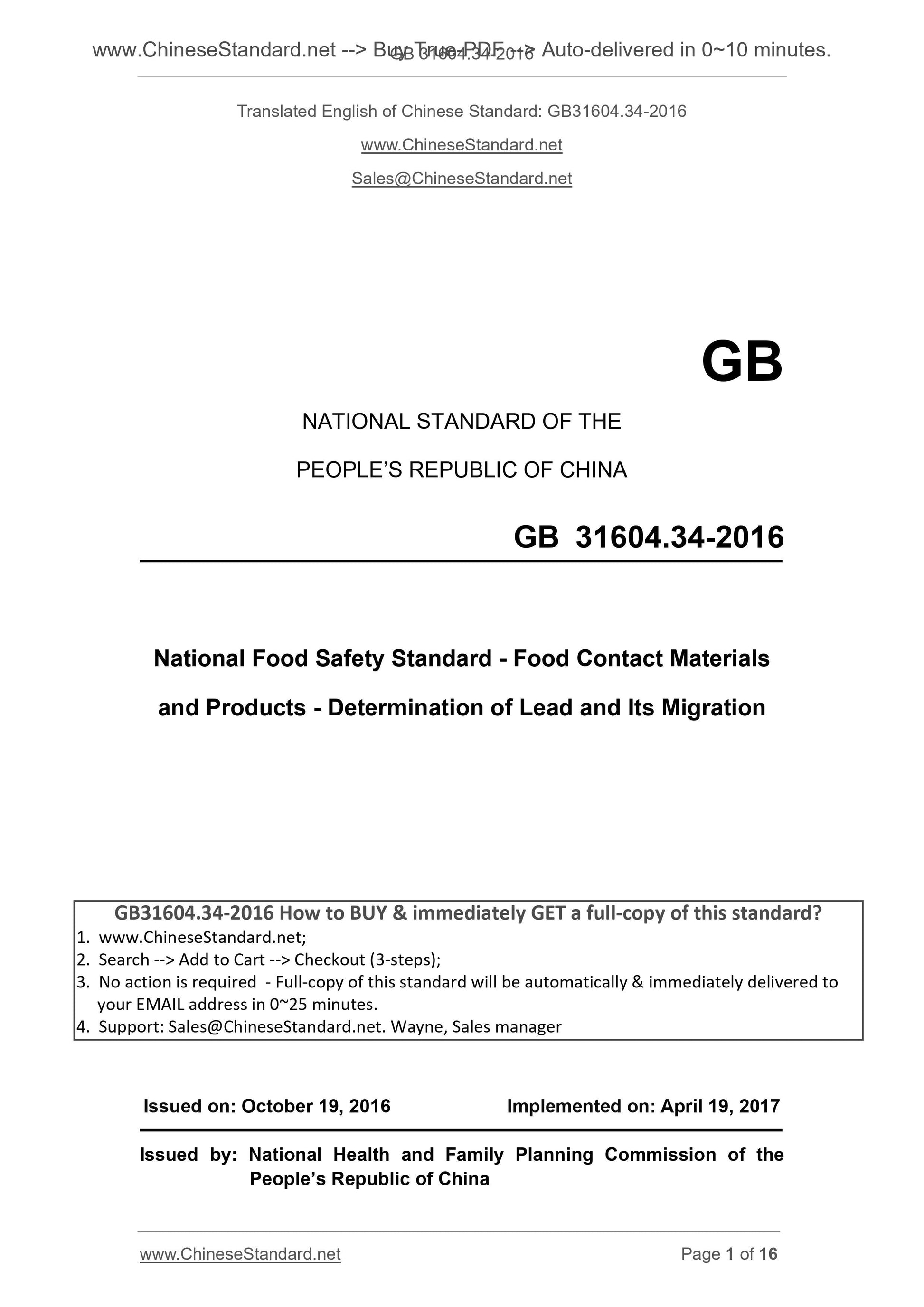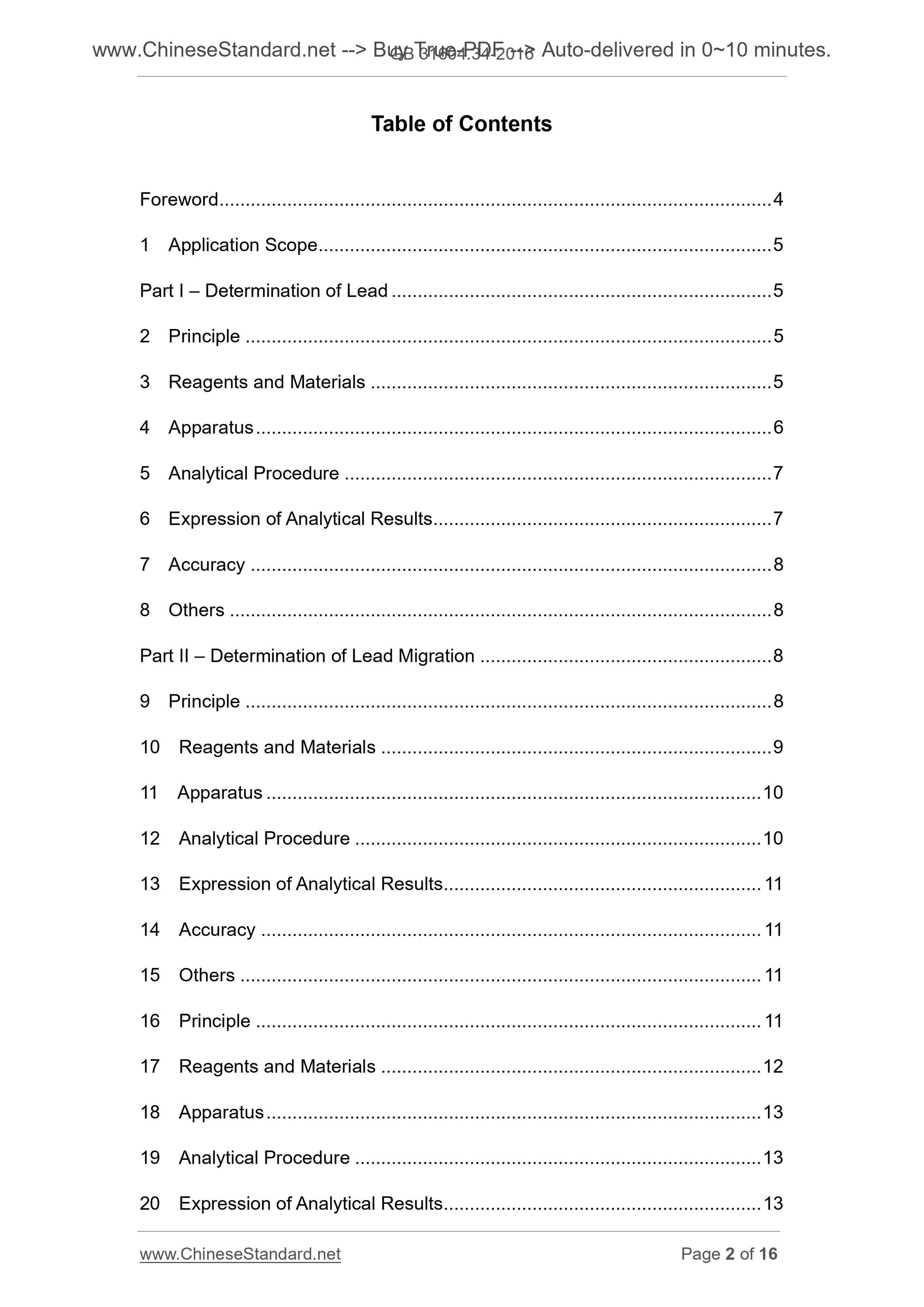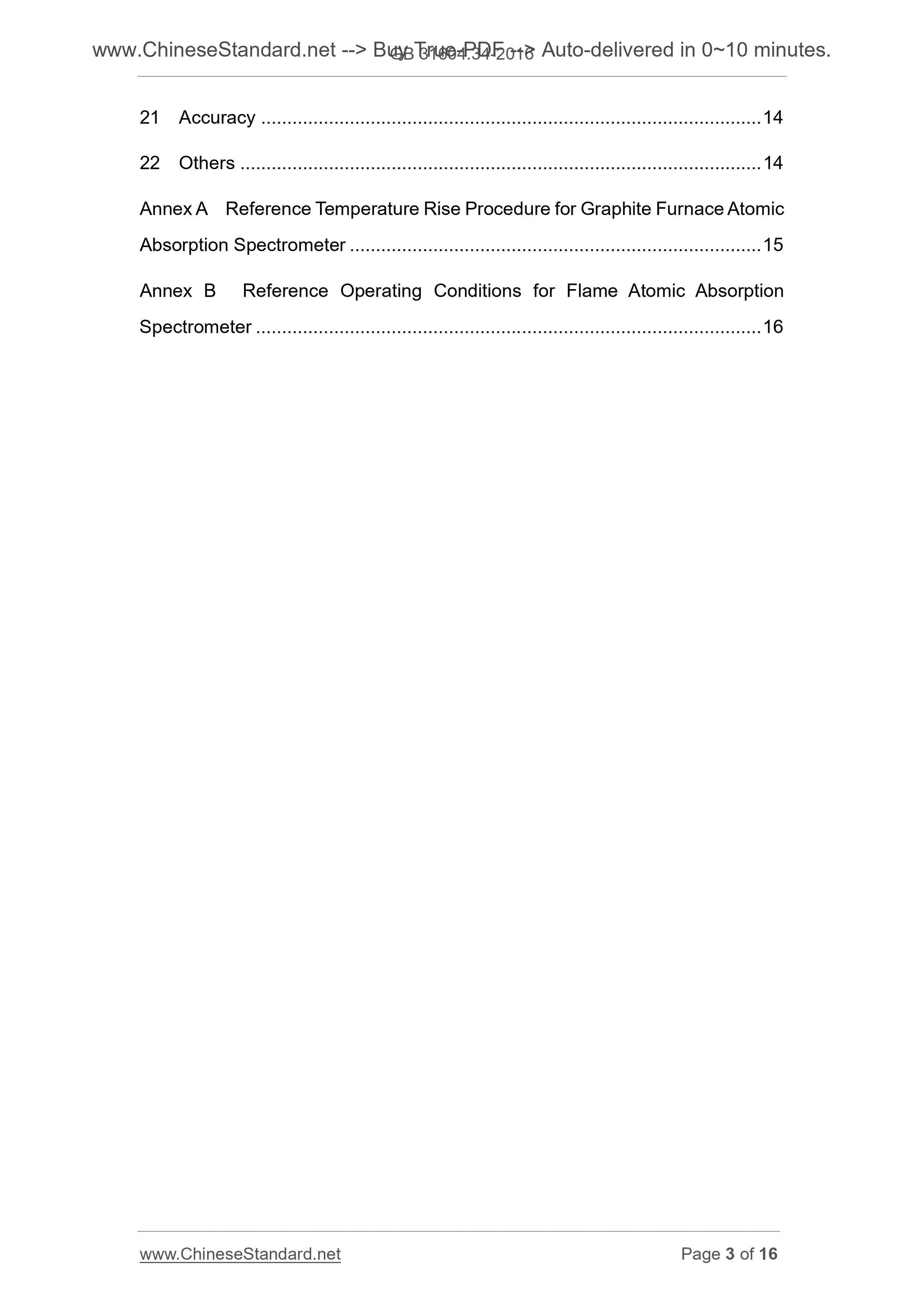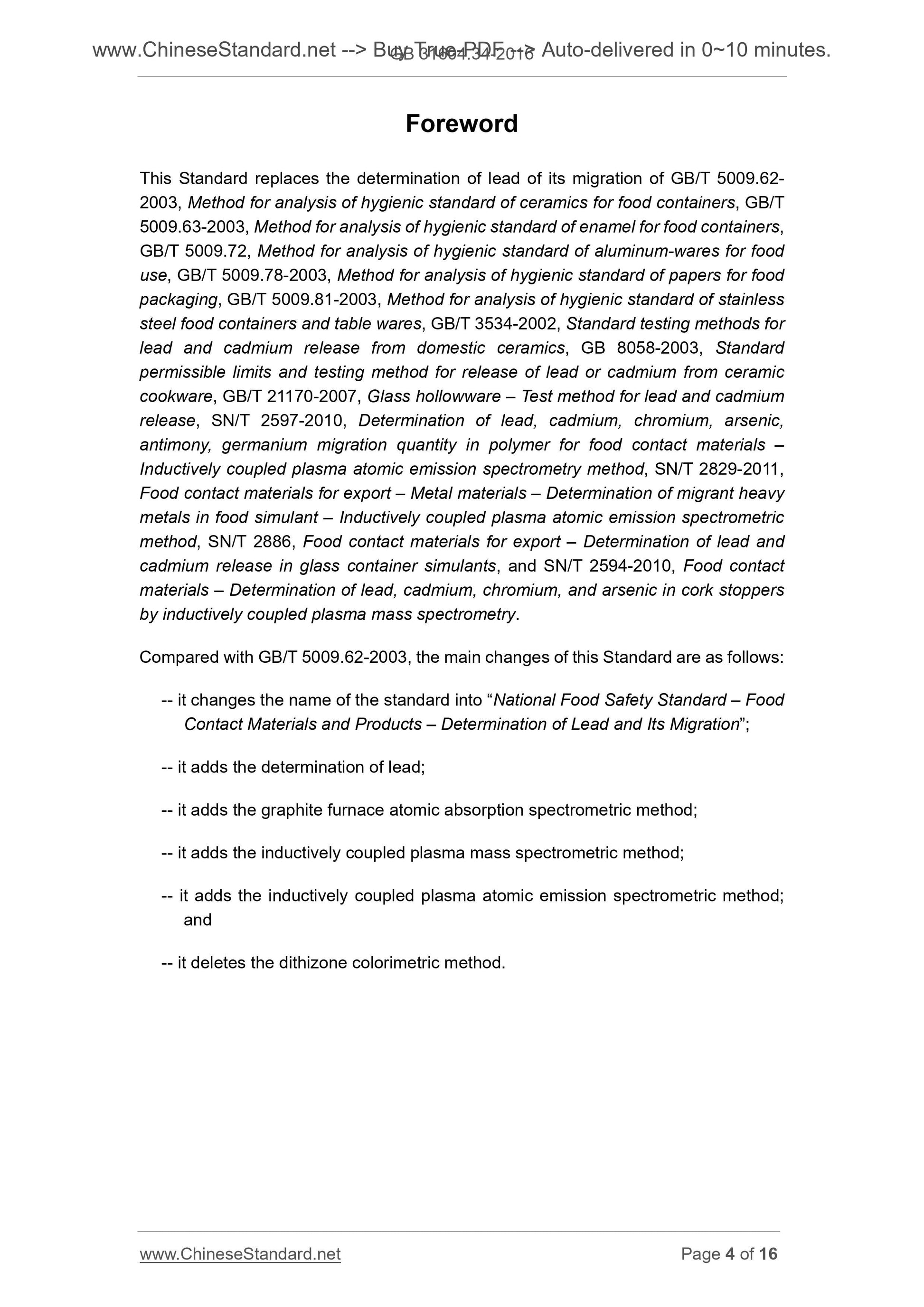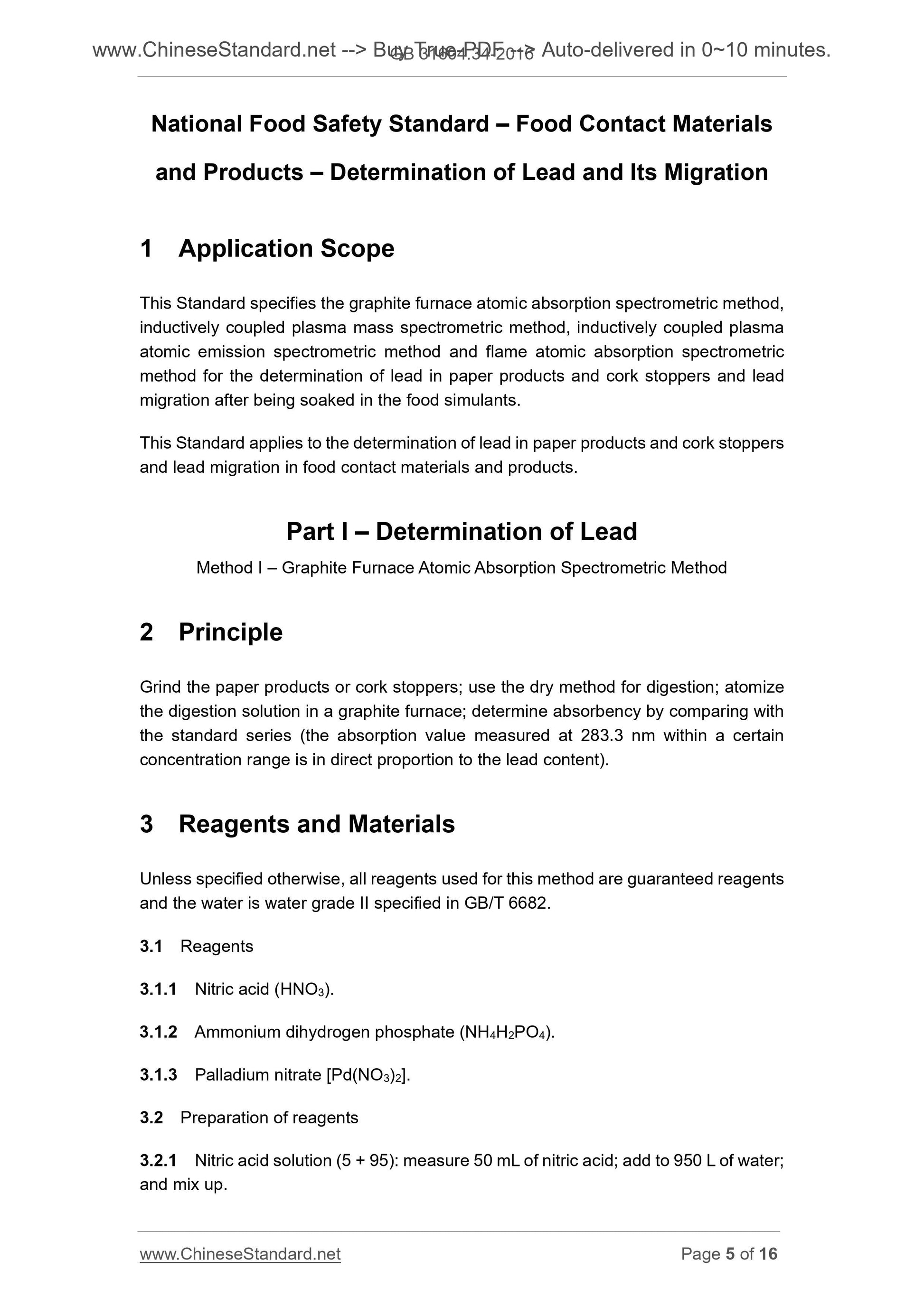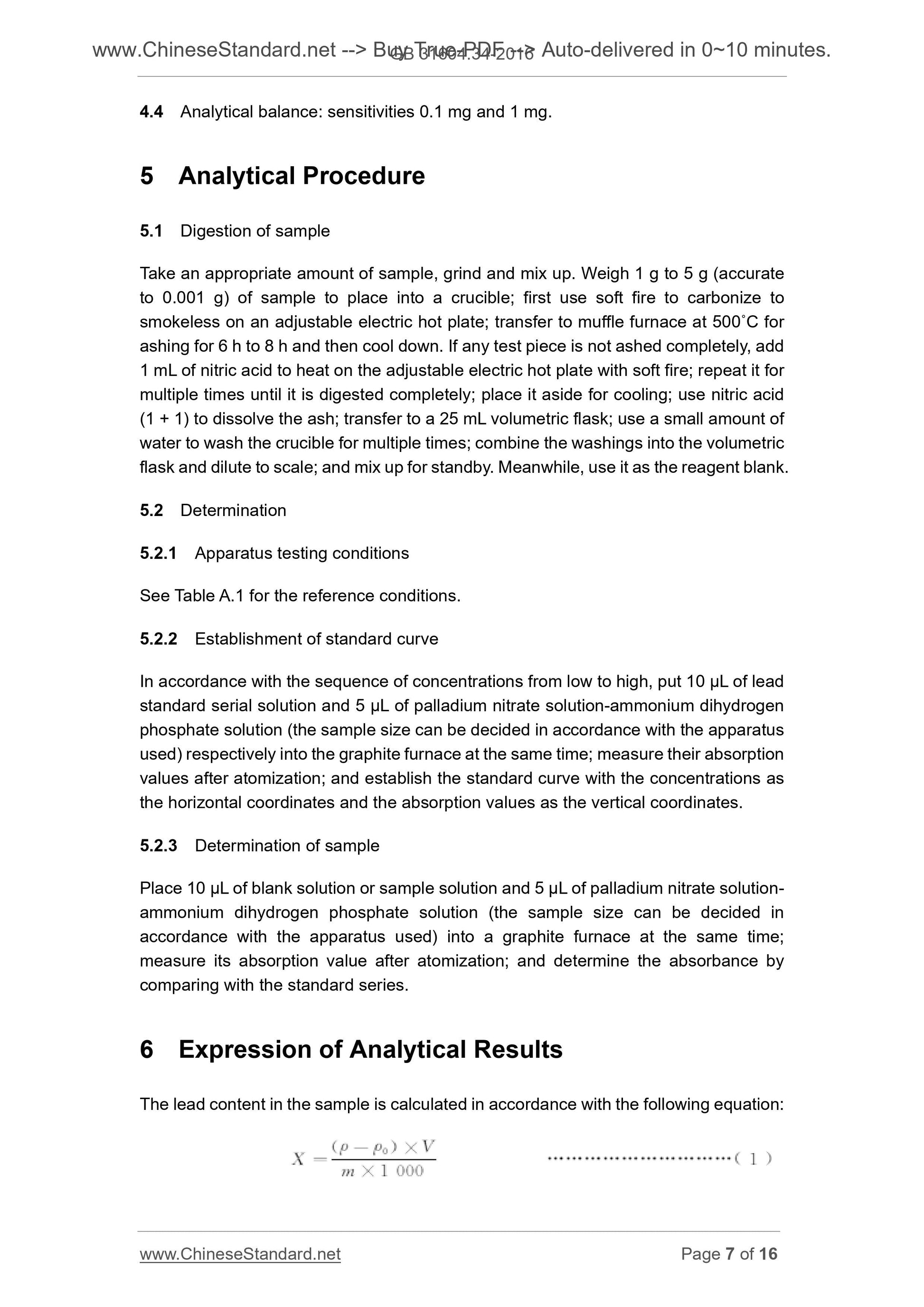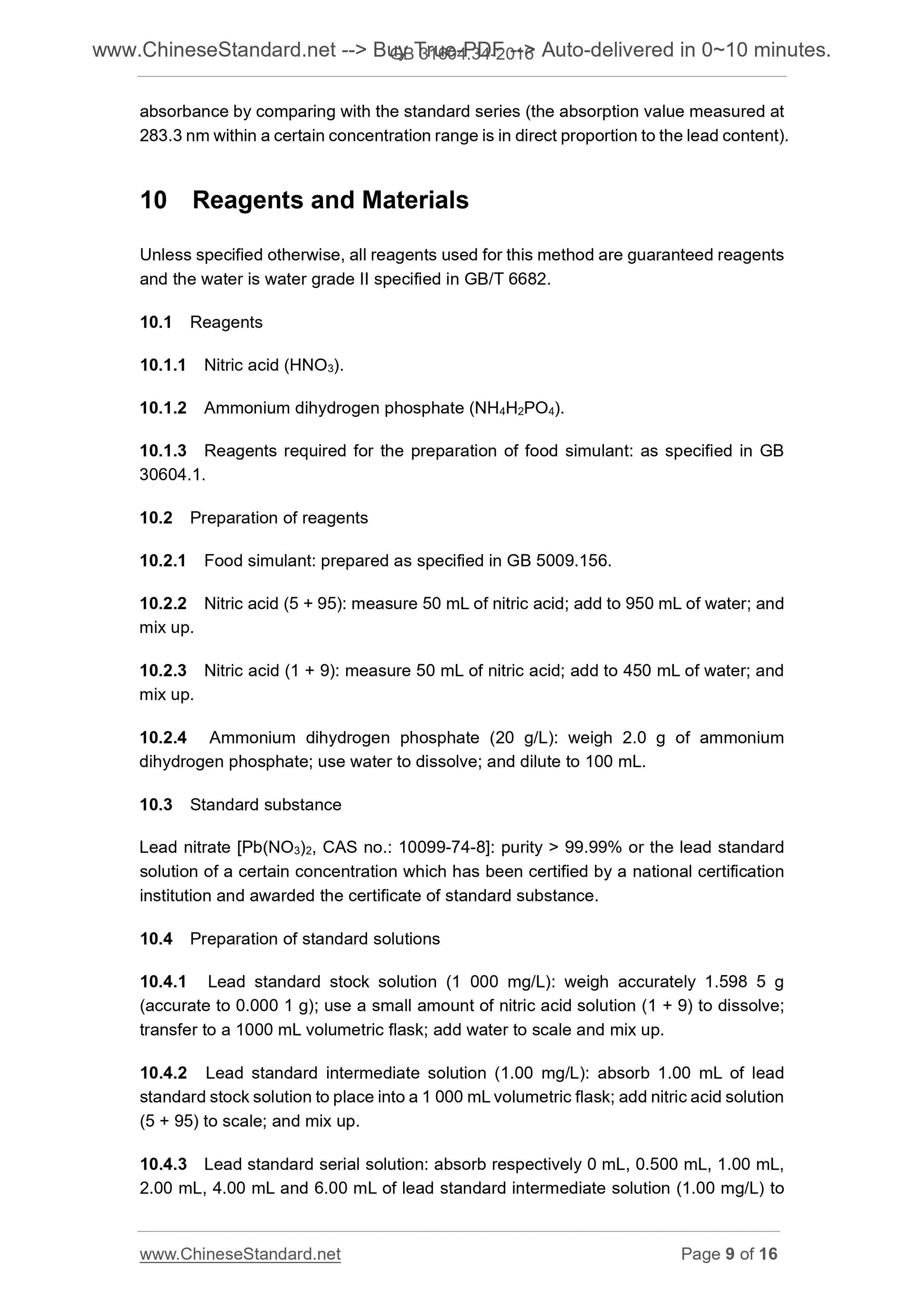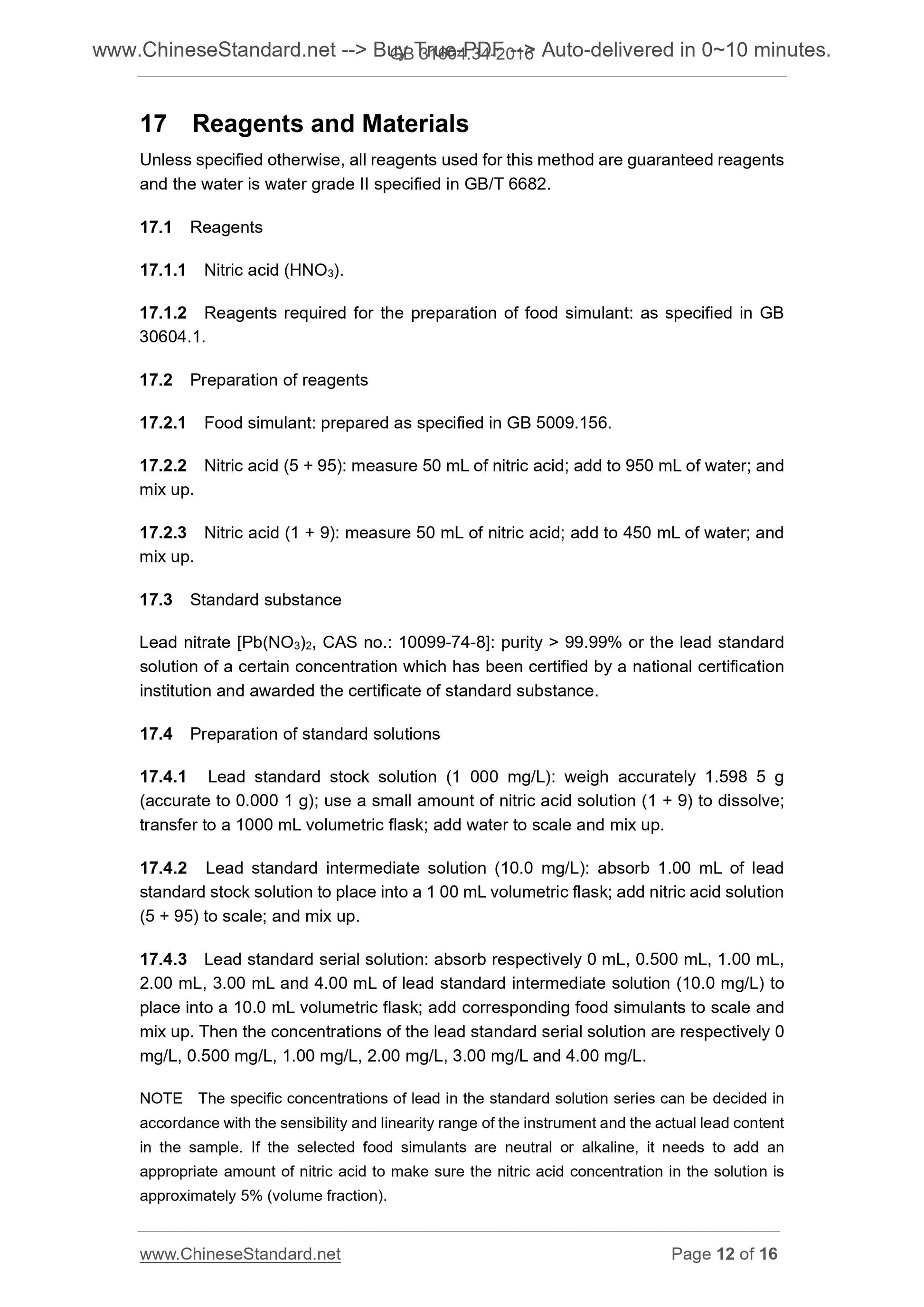1
/
of
8
PayPal, credit cards. Download editable-PDF & invoice in 1 second!
GB 31604.34-2016 English PDF
GB 31604.34-2016 English PDF
Regular price
$95.00 USD
Regular price
Sale price
$95.00 USD
Unit price
/
per
Shipping calculated at checkout.
Couldn't load pickup availability
Delivery: 3 seconds. Download true-PDF + Invoice.
Get QUOTATION in 1-minute: Click GB 31604.34-2016
Historical versions: GB 31604.34-2016
Preview True-PDF (Reload/Scroll if blank)
GB 31604.34-2016: Method for analysis of hygienic standard of papers for food packaging
GB 31604.34-2016
GB
NATIONAL STANDARD OF THE
PEOPLE’S REPUBLIC OF CHINA
National Food Safety Standard - Food Contact Materials
and Products - Determination of Lead and Its Migration
食品接触材料及制品
ISSUED ON. OCTOBER 19, 2016
IMPLEMENTED ON. APRIL 19, 2017
Issued by. National Health and Family Planning Commission of the
People’s Republic of China
Table of Contents
Foreword ... 4
1 Application Scope ... 5
Part I – Determination of Lead ... 5
2 Principle ... 5
3 Reagents and Materials ... 5
4 Apparatus ... 6
5 Analytical Procedure ... 7
6 Expression of Analytical Results ... 7
7 Accuracy ... 8
8 Others ... 8
Part II – Determination of Lead Migration ... 8
9 Principle ... 8
10 Reagents and Materials ... 9
11 Apparatus ... 10
12 Analytical Procedure ... 10
13 Expression of Analytical Results ... 11
14 Accuracy ... 11
15 Others ... 11
16 Principle ... 11
17 Reagents and Materials ... 12
18 Apparatus ... 13
19 Analytical Procedure ... 13
20 Expression of Analytical Results ... 13
21 Accuracy ... 14
22 Others ... 14
Annex A Reference Temperature Rise Procedure for Graphite Furnace Atomic
Absorption Spectrometer ... 15
Annex B Reference Operating Conditions for Flame Atomic Absorption
Spectrometer ... 16
Foreword
This Standard replaces the determination of lead of its migration of GB/T 5009.62-
2003, Method for analysis of hygienic standard of ceramics for food containers, GB/T
5009.63-2003, Method for analysis of hygienic standard of enamel for food containers,
GB/T 5009.72, Method for analysis of hygienic standard of aluminum-wares for food
use, GB/T 5009.78-2003, Method for analysis of hygienic standard of papers for food
packaging, GB/T 5009.81-2003, Method for analysis of hygienic standard of stainless
steel food containers and table wares, GB/T 3534-2002, Standard testing methods for
lead and cadmium release from domestic ceramics, GB 8058-2003, Standard
permissible limits and testing method for release of lead or cadmium from ceramic
cookware, GB/T 21170-2007, Glass hollowware – Test method for lead and cadmium
release, SN/T 2597-2010, Determination of lead, cadmium, chromium, arsenic,
antimony, germanium migration quantity in polymer for food contact materials –
Inductively coupled plasma atomic emission spectrometry method, SN/T 2829-2011,
Food contact materials for export – Metal materials – Determination of migrant heavy
metals in food simulant – Inductively coupled plasma atomic emission spectrometric
method, SN/T 2886, Food contact materials for export – Determination of lead and
cadmium release in glass container simulants, and SN/T 2594-2010, Food contact
materials – Determination of lead, cadmium, chromium, and arsenic in cork stoppers
by inductively coupled plasma mass spectrometry.
Compared with GB/T 5009.62-2003, the main changes of this Standard are as follows.
-- it changes the name of the standard into “National Food Safety Standard – Food
Contact Materials and Products – Determination of Lead and Its Migration”;
-- it adds the determination of lead;
-- it adds the graphite furnace atomic absorption spectrometric method;
-- it adds the inductively coupled plasma mass spectrometric method;
-- it adds the inductively coupled plasma atomic emission spectrometric method;
and
-- it deletes the dithizone colorimetric method.
National Food Safety Standard – Food Contact Materials
and Products – Determination of Lead and Its Migration
1 Application Scope
This Standard specifies the graphite furnace atomic absorption spectrometric method,
inductively coupled plasma mass spectrometric method, inductively coupled plasma
atomic emission spectrometric method and flame atomic absorption spectrometric
method for the determination of lead in paper products and cork stoppers and lead
migration after being soaked in the food simulants.
This Standard applies to the determination of lead in paper products and cork stoppers
and lead migration in food contact materials and products.
Part I – Determination of Lead
Method I – Graphite Furnace Atomic Absorption Spectrometric Method
2 Principle
Grind the paper products or cork stoppers; use the dry method for digestion; atomize
the digestion solution in a graphite furnace; determine absorbency by comparing with
the standard series (the absorption value measured at 283.3 nm within a certain
concentration range is in direct proportion to the lead content).
3 Reagents and Materials
Unless specified otherwise, all reagents used for this method are guaranteed reagents
and the water is water grade II specified in GB/T 6682.
3.1 Reagents
3.1.1 Nitric acid (HNO3).
3.1.2 Ammonium dihydrogen phosphate (NH4H2PO4).
3.1.3 Palladium nitrate [Pd(NO3)2].
3.2 Preparation of reagents
3.2.1 Nitric acid solution (5 + 95). measure 50 mL of nitric acid; add to 950 L of water;
and mix up.
4.4 Analytical balance. sensitivities 0.1 mg and 1 mg.
5 Analytical Procedure
5.1 Digestion of sample
Take an appropriate amount of sample, grind and mix up. Weigh 1 g to 5 g (accurate
to 0.001 g) of sample to place into a crucible; first use soft fire to carbonize to
smokeless on an adjustable electric hot plate; transfer to muffle furnace at 500˚C for
ashing for 6 h to 8 h and then cool down. If any test piece is not ashed completely, add
1 mL of nitric acid to heat on the adjustable electric hot plate with soft fire; repeat it for
multiple times until it is digested completely; place it aside for cooling; use nitric acid
(1 + 1) to dissolve the ash; transfer to a 25 mL volumetric flask; use a small amount of
water to wash the crucible for multiple times; combine the washings into the volumetric
flask and dilute to scale; and mix up for standby. Meanwhile, use it as the reagent blank.
5.2 Determination
5.2.1 Apparatus testing conditions
See Table A.1 for the reference conditions.
5.2.2 Establishment of standard curve
In accordance with the sequence of concentrations from low to high, put 10 μL of lead
standard serial solution and 5 μL of palladium nitrate solution-ammonium dihydrogen
phosphate solution (the sample size can be decided in accordance with the apparatus
used) respectively into the graphite furnace at the same time; measure their absorption
values after atomization; and establish the standard curve with the concentrations as
the horizontal coordinates and the absorption values as the vertical coordinates.
5.2.3 Determination of sample
Place 10 μL of blank solution or sample solution and 5 μL of palladium nitrate solution-
ammonium dihydrogen phosphate solution (the sample size can be decided in
accordance with the apparatus used) into a graphite furnace at the same time;
measure its absorption value after atomization; and determine the absorbance by
comparing with the standard series.
6 Expression of Analytical Results
The lead content in the sample is calculated in accordance with the following equation.
absorbance by comparing with the standard series (the absorption value measured at
283.3 nm within a certain concentration range is in direct proportion to the lead content).
10 Reagents and Materials
Unless specified otherwise, all reagents used for this method are guaranteed reagents
and the water is water grade II specified in GB/T 6682.
10.1 Reagents
10.1.1 Nitric acid (HNO3).
10.1.2 Ammonium dihydrogen phosphate (NH4H2PO4).
10.1.3 Reagents requir...
Get QUOTATION in 1-minute: Click GB 31604.34-2016
Historical versions: GB 31604.34-2016
Preview True-PDF (Reload/Scroll if blank)
GB 31604.34-2016: Method for analysis of hygienic standard of papers for food packaging
GB 31604.34-2016
GB
NATIONAL STANDARD OF THE
PEOPLE’S REPUBLIC OF CHINA
National Food Safety Standard - Food Contact Materials
and Products - Determination of Lead and Its Migration
食品接触材料及制品
ISSUED ON. OCTOBER 19, 2016
IMPLEMENTED ON. APRIL 19, 2017
Issued by. National Health and Family Planning Commission of the
People’s Republic of China
Table of Contents
Foreword ... 4
1 Application Scope ... 5
Part I – Determination of Lead ... 5
2 Principle ... 5
3 Reagents and Materials ... 5
4 Apparatus ... 6
5 Analytical Procedure ... 7
6 Expression of Analytical Results ... 7
7 Accuracy ... 8
8 Others ... 8
Part II – Determination of Lead Migration ... 8
9 Principle ... 8
10 Reagents and Materials ... 9
11 Apparatus ... 10
12 Analytical Procedure ... 10
13 Expression of Analytical Results ... 11
14 Accuracy ... 11
15 Others ... 11
16 Principle ... 11
17 Reagents and Materials ... 12
18 Apparatus ... 13
19 Analytical Procedure ... 13
20 Expression of Analytical Results ... 13
21 Accuracy ... 14
22 Others ... 14
Annex A Reference Temperature Rise Procedure for Graphite Furnace Atomic
Absorption Spectrometer ... 15
Annex B Reference Operating Conditions for Flame Atomic Absorption
Spectrometer ... 16
Foreword
This Standard replaces the determination of lead of its migration of GB/T 5009.62-
2003, Method for analysis of hygienic standard of ceramics for food containers, GB/T
5009.63-2003, Method for analysis of hygienic standard of enamel for food containers,
GB/T 5009.72, Method for analysis of hygienic standard of aluminum-wares for food
use, GB/T 5009.78-2003, Method for analysis of hygienic standard of papers for food
packaging, GB/T 5009.81-2003, Method for analysis of hygienic standard of stainless
steel food containers and table wares, GB/T 3534-2002, Standard testing methods for
lead and cadmium release from domestic ceramics, GB 8058-2003, Standard
permissible limits and testing method for release of lead or cadmium from ceramic
cookware, GB/T 21170-2007, Glass hollowware – Test method for lead and cadmium
release, SN/T 2597-2010, Determination of lead, cadmium, chromium, arsenic,
antimony, germanium migration quantity in polymer for food contact materials –
Inductively coupled plasma atomic emission spectrometry method, SN/T 2829-2011,
Food contact materials for export – Metal materials – Determination of migrant heavy
metals in food simulant – Inductively coupled plasma atomic emission spectrometric
method, SN/T 2886, Food contact materials for export – Determination of lead and
cadmium release in glass container simulants, and SN/T 2594-2010, Food contact
materials – Determination of lead, cadmium, chromium, and arsenic in cork stoppers
by inductively coupled plasma mass spectrometry.
Compared with GB/T 5009.62-2003, the main changes of this Standard are as follows.
-- it changes the name of the standard into “National Food Safety Standard – Food
Contact Materials and Products – Determination of Lead and Its Migration”;
-- it adds the determination of lead;
-- it adds the graphite furnace atomic absorption spectrometric method;
-- it adds the inductively coupled plasma mass spectrometric method;
-- it adds the inductively coupled plasma atomic emission spectrometric method;
and
-- it deletes the dithizone colorimetric method.
National Food Safety Standard – Food Contact Materials
and Products – Determination of Lead and Its Migration
1 Application Scope
This Standard specifies the graphite furnace atomic absorption spectrometric method,
inductively coupled plasma mass spectrometric method, inductively coupled plasma
atomic emission spectrometric method and flame atomic absorption spectrometric
method for the determination of lead in paper products and cork stoppers and lead
migration after being soaked in the food simulants.
This Standard applies to the determination of lead in paper products and cork stoppers
and lead migration in food contact materials and products.
Part I – Determination of Lead
Method I – Graphite Furnace Atomic Absorption Spectrometric Method
2 Principle
Grind the paper products or cork stoppers; use the dry method for digestion; atomize
the digestion solution in a graphite furnace; determine absorbency by comparing with
the standard series (the absorption value measured at 283.3 nm within a certain
concentration range is in direct proportion to the lead content).
3 Reagents and Materials
Unless specified otherwise, all reagents used for this method are guaranteed reagents
and the water is water grade II specified in GB/T 6682.
3.1 Reagents
3.1.1 Nitric acid (HNO3).
3.1.2 Ammonium dihydrogen phosphate (NH4H2PO4).
3.1.3 Palladium nitrate [Pd(NO3)2].
3.2 Preparation of reagents
3.2.1 Nitric acid solution (5 + 95). measure 50 mL of nitric acid; add to 950 L of water;
and mix up.
4.4 Analytical balance. sensitivities 0.1 mg and 1 mg.
5 Analytical Procedure
5.1 Digestion of sample
Take an appropriate amount of sample, grind and mix up. Weigh 1 g to 5 g (accurate
to 0.001 g) of sample to place into a crucible; first use soft fire to carbonize to
smokeless on an adjustable electric hot plate; transfer to muffle furnace at 500˚C for
ashing for 6 h to 8 h and then cool down. If any test piece is not ashed completely, add
1 mL of nitric acid to heat on the adjustable electric hot plate with soft fire; repeat it for
multiple times until it is digested completely; place it aside for cooling; use nitric acid
(1 + 1) to dissolve the ash; transfer to a 25 mL volumetric flask; use a small amount of
water to wash the crucible for multiple times; combine the washings into the volumetric
flask and dilute to scale; and mix up for standby. Meanwhile, use it as the reagent blank.
5.2 Determination
5.2.1 Apparatus testing conditions
See Table A.1 for the reference conditions.
5.2.2 Establishment of standard curve
In accordance with the sequence of concentrations from low to high, put 10 μL of lead
standard serial solution and 5 μL of palladium nitrate solution-ammonium dihydrogen
phosphate solution (the sample size can be decided in accordance with the apparatus
used) respectively into the graphite furnace at the same time; measure their absorption
values after atomization; and establish the standard curve with the concentrations as
the horizontal coordinates and the absorption values as the vertical coordinates.
5.2.3 Determination of sample
Place 10 μL of blank solution or sample solution and 5 μL of palladium nitrate solution-
ammonium dihydrogen phosphate solution (the sample size can be decided in
accordance with the apparatus used) into a graphite furnace at the same time;
measure its absorption value after atomization; and determine the absorbance by
comparing with the standard series.
6 Expression of Analytical Results
The lead content in the sample is calculated in accordance with the following equation.
absorbance by comparing with the standard series (the absorption value measured at
283.3 nm within a certain concentration range is in direct proportion to the lead content).
10 Reagents and Materials
Unless specified otherwise, all reagents used for this method are guaranteed reagents
and the water is water grade II specified in GB/T 6682.
10.1 Reagents
10.1.1 Nitric acid (HNO3).
10.1.2 Ammonium dihydrogen phosphate (NH4H2PO4).
10.1.3 Reagents requir...
Share
